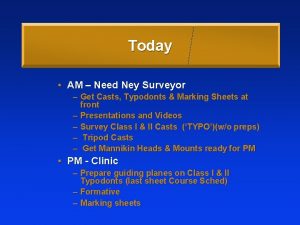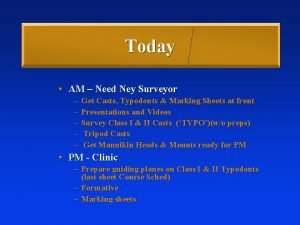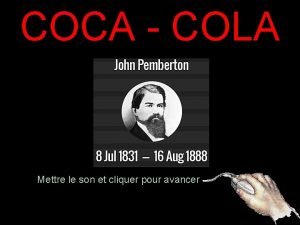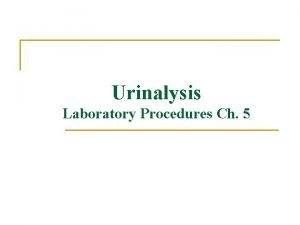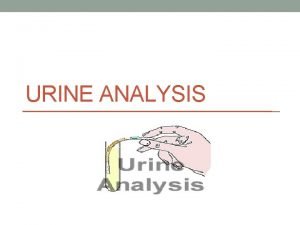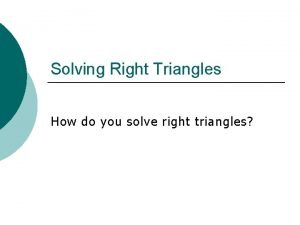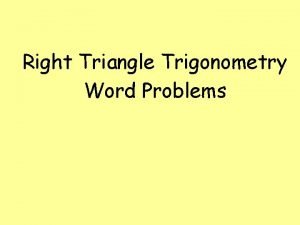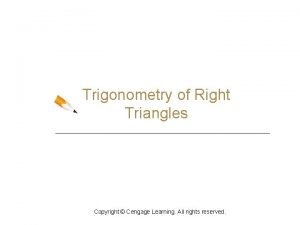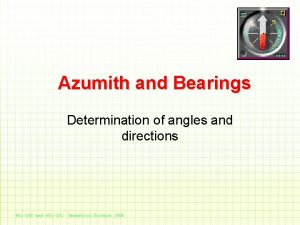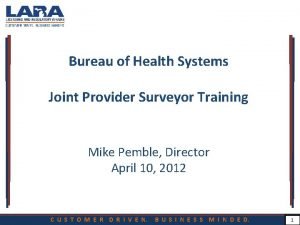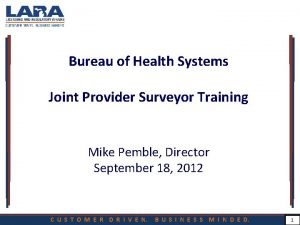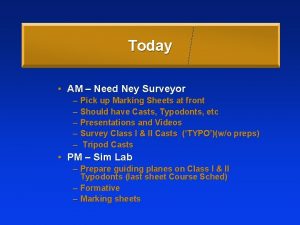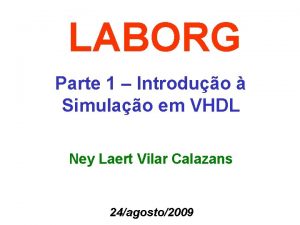Today AM Need Ney Surveyor Get Casts Typodonts








































- Slides: 40

Today • AM – Need Ney Surveyor – – – Get Casts, Typodonts & Marking Sheets at front Presentations and Videos Survey Class I & II Casts (‘TYPO’)(w/o preps) Tripod Casts Get Mannikin Heads & Mounts ready for PM • PM - Clinic – Prepare guiding planes on Class I & II Typodonts (last sheet Course Sched) – Formative – Marking sheets

Surveying, Path of Insertion, Guiding Planes

Definitions • Height of contour • Undercut = Infrabulge • Suprabulge

Rule: Retentive tip should usually be designed to be placed in the gingival 1/3

Path of Insertion • Path that the prosthesis is – Placed/removed – Usually a single path

Advantages of a Single Path of Insertion • Equalizes retention

Advantages of a Single Path of Insertion • Bracing and Cross-arch Stabilization

Advantages of a Single Path of Insertion • Minimizes torque on abutments

Advantages of a Single Path of Insertion • Allows removal without encountering interferences

Advantages of a Single Path of Insertion • Directs forces along axes of teeth

Advantages of a Single Path of Insertion • Provides frictional retention

Selecting a Single Path of Insertion • Use a dental surveyor to – Select path – Prepare guiding planes

Movies: Parts of a Surveyor Surveying

Guiding Plane Preparation • Where rigid components contact abutments • Proximal Plates • Bracing Arms • Rigid portions of Retentive Arms

Altering Path of Insertion • Proximal surfaces similar undercuts • Retentive areas similar undercuts

Selecting a Path of Insertion • Modify tilt if necessary – Soft tissue interferences

Selecting a Path of Insertion • Modify tilt if necessary – Esthetics

Once Path Selected • Instructor: – Approves path – Demo: - Mark heights of contour with carbon marker - Tripod

Optimal Path of Insertion • Retentive undercuts equalized – Retentive arm has a different path of escapement than guiding plane, so it must flex during removal

Optimal Path of Insertion • Retentive undercuts equalized – Ideally, retentive arms should oppose each other on opposite sides of the arch

Optimal Path of Insertion • Minimize severe tooth & soft tissue interferences

Optimal Path of Insertion • Esthetics – Minimize display of clasps, metal components

Optimal Path of Insertion • Prepare Guiding Planes – Flat surfaces parallel to path of insertion – Control & limit movement of RPD – Initial contacts for RPD

Effectiveness of Guideplanes • Most effective when: – Parallel to each other – More than one common axial surface

Effectiveness of Guideplanes • Most effective when: – Directly opposing each other

Effectiveness of Guideplanes • Most effective when: – Prepared on several teeth – Cover a large surface area

Movies: Preparing Guiding Planes Assessing Guide Planes

Assessing Guiding Planes Proximal View Carbon Markings Facial View

Preparing Guiding Planes • Select path of insertion • Design Partial Denture * • Select number & position of guiding planes • Prepare guiding planes

Use Surveyor to Align Bur Intraorally When Preparing Guide Planes Cast should be on Surveyor Close to Operator to Compare Orientation of Analyzing Rod and Bur to the Tooth

FINGER REST!

Burs 8837 K-014 • Long Cylindrical Carbide or Diamond (8837 K 014)

Guiding Plane Dimensions

Axial Surface Already Parallel to Path of Insertion • NO Preparation !

Polish Prepared Surfaces • Rubber wheels or points

Prepare Guiding Planes First

Effects of Guiding Planes On Retention & Stability • Maintains Retention

Effects of Guiding Planes On Retention & Stability • Minimizes Need for Retention

Effects of Guiding Planes On Retention & Stability • Stabilizing Teeth

Marking Sheets
 Height of contour of tooth
Height of contour of tooth Undercut gauge of the surveyor
Undercut gauge of the surveyor Ney surveyor parts
Ney surveyor parts Get in get on get off get out
Get in get on get off get out You're my kryptonite metaphor
You're my kryptonite metaphor Ann eliza clifford lewis
Ann eliza clifford lewis Ney chon
Ney chon I bar clasp indications
I bar clasp indications Epithelial cells in urine images
Epithelial cells in urine images Flute casts flow direction
Flute casts flow direction Cystine crystals in urine
Cystine crystals in urine Theres no fear in love
Theres no fear in love The chestnut casts his flambeaux
The chestnut casts his flambeaux Rbc
Rbc Kind of triangle
Kind of triangle Cast care nursing
Cast care nursing Azotemia
Azotemia Urine
Urine Right triangle trigonometry word problems
Right triangle trigonometry word problems Trigonometric ratios
Trigonometric ratios Fingerprint galton details
Fingerprint galton details Today meeting or today's meeting
Today meeting or today's meeting Today's lesson or today lesson
Today's lesson or today lesson Today class or today's class
Today class or today's class Today's lesson or today lesson
Today's lesson or today lesson Today meeting or today's meeting
Today meeting or today's meeting How do animals get the nitrogen they need
How do animals get the nitrogen they need How do plants get nitrogen
How do plants get nitrogen Work today get paid tomorrow
Work today get paid tomorrow Get up get moving quiz
Get up get moving quiz Germer
Germer Get up get moving quiz
Get up get moving quiz Get up get moving quiz
Get up get moving quiz Get sequence get another sequence pseudocode
Get sequence get another sequence pseudocode Get focused get results
Get focused get results Diff between prismatic and surveyor compass
Diff between prismatic and surveyor compass Joint provider surveyor training michigan
Joint provider surveyor training michigan Prismatic compass and surveyor compass
Prismatic compass and surveyor compass Infection control surveyor worksheet
Infection control surveyor worksheet Army accreditation matrix
Army accreditation matrix Joint provider surveyor training michigan
Joint provider surveyor training michigan
